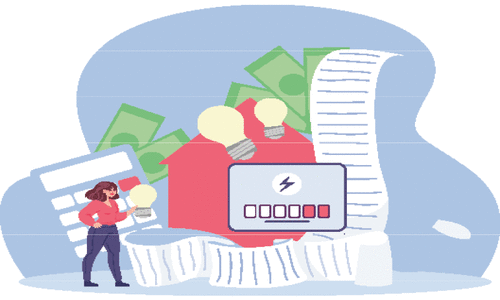For those of us born into less privileged Pakistani households, loadshedding used to be as universal as the recurrence of day and night. While others think of electricity as an omnipresent means to go about their routine life, our most mundane tasks were organised around its (un)availability. Many would remember the anxiety of ironing a kameez and rushing to fetch the shalwar, fearing the utility man’s instinct to cut power would render their plans too ambitious.
Fast forward, and things appear to be better. Although electricity supply is fairly reliable in many parts of the country, many people still face starkly contrasting choices, for they might have to pledge their next pay cheque against ravenous electricity bills to afford a crisp, crease-free kameez and shalwar every day. Meanwhile, those who can spend a few hundred thousand rupees upfront are growing their reliance on the cheapest source of our times: solar energy. A case study from Africa offers the crystal ball to show how these developments will shape the future of Pakistan’s power sector.
South Africans are accustomed to an expensive and unreliable electricity supply. Their embattled utility, Eskom, relies on state handouts to stay afloat and has been accused of “neglect, mismanagement and state capture”. Corruption is so widespread that otherwise reputable firms, such as McKinsey & Co. and ABB, have agreed to return hundreds of millions of dollars ostensibly paid in bribes. No wonder the utility has failed the country’s once burgeoning economy. But there were good times as well.
Eskom ran its operations profitably in the 2000s. However, it underestimated growing power demand and didn’t make the necessary investments. As economic growth accelerated during 2004-07, electricity demand outstripped supply, triggering rolling blackouts in 2007-08. Jacob Zuma’s ascent to the presidency proved ill-timed, too, since his cronies, the Gupta family, allegedly abetted corruption and held the utility hostage to state capture.
As Eskom’s performance deteriorated, it slapped aggressive price hikes to recover soaring costs. In 2015, it generated sales worth 146.3 billion South African rands, which ballooned to 257.8bn rands in 2023, representing a 100 per cent increase in the utility’s revenue for each unit of electricity sold. Yet, it went from making an annual net profit of 3.7bn rands to incurring a 23.9bn rand loss by 2023.
Soaring electricity prices and inexpensive solar energy pose an existential threat to Pakistan’s inept power utilities
High power prices stimulated solar PV installations, which are estimated to expand by 11-14 gigawatts (GW) during 2020-25 and another 20GW from 2026 to 2030. Consequently, Eskom is trapped in a “utility death spiral” — a jargon denoting the ultimate collapse of a utility due to soaring costs, consumer defection, obsolete business models etc. Any subsequent tariff hikes will incentivise the ratepayer further to opt for inexpensive solar power and accelerate Eskom’s economic decay. So, what does this mean for Pakistan?
The signs of the brewing troubles for our national utilities are aplenty. Consider, for example, the data collated by Herald Analytics, an energy data outfit, showing how the benchmark cost of electricity crept up from Rs13.4/kWh in FY20 to Rs24.8/kWh in FY23. It has been rebased to Rs35.5/kWh for FY25 and will likely be revised upwards in monthly and quarterly reviews.
Resultantly, the end-user tariff will reach Rs50-60/kWh once all taxes and surcharges are accounted for. This is no good news for utilities whose sales fell by 9.4pc year-on-year to 113 terawatt per hour (TWh) in FY23. However, thermal IPPs supplied 58.3TWh of electricity in FY23 compared to 78.4TWh a year before, meaning there was enough capacity to satisfy much higher demand.
Secondly, Chinese customs data suggest solar PV modules worth $2.9bn were shipped to Pakistan from January 2023 to June 2024. It has led BloombergNEF, a global research firm, to predict Pakistan will have 22-27GW of solar capacity by end-2024, installed primarily by residential and industrial sectors and sufficient to generate 30TWh of electricity in a year.
Power utilities’ business fundamentals are under siege due to their lack of innovation. High reliance on economies of scale and cross-subsidisation across consumer categories is a major weakness. Efforts to grow their sales will bear no fruit. On the contrary, high-paying segments will gradually draw fewer units from the grid, forcing thermal and nuclear plants to reduce production and worsen the unit economics of grid-supplied electricity.
To illustrate, note that these plants will receive about Rs1.37 trillion in capacity charges in FY25 even if kept idle.
Further complications abound still as utilities’ tumbling sales will squeeze the government’s reported tax revenue of Rs954bn from electricity consumers. Fellow analysts are ringing the alarm on potential threats to our socio-economic fabric.
The current administration’s concerted focus on reducing power prices through IPP contract renegotiations may delay the conventional utilities’ looming collapse by a few years, but it does little to address the deep-rooted structural issues.
Power utilities face an existential threat from excellent solar economics, which will not afford future governments any room to manoeuvre when coupled with cheaper battery storage solutions. The incumbents have far less time and fewer policy options than they realise.
The writer is an analyst.
Email: sohaibrmalik@gmail.com
Published in Dawn, The Business and Finance Weekly, September 30th, 2024















































Dear visitor, the comments section is undergoing an overhaul and will return soon.